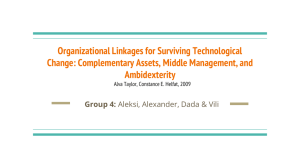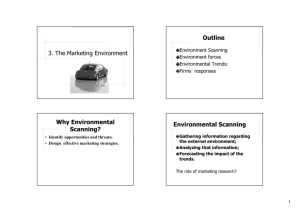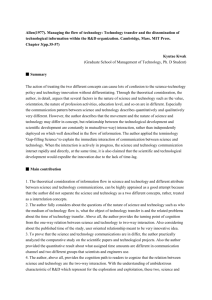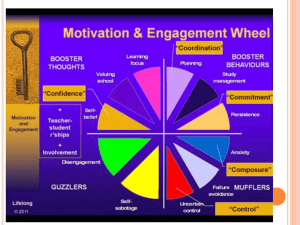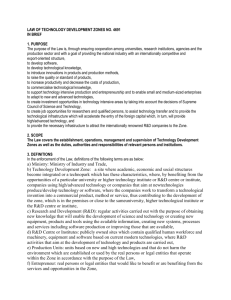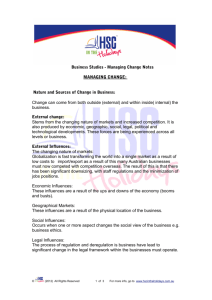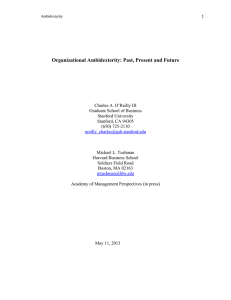Group 9 Presis 3 (1)
advertisement
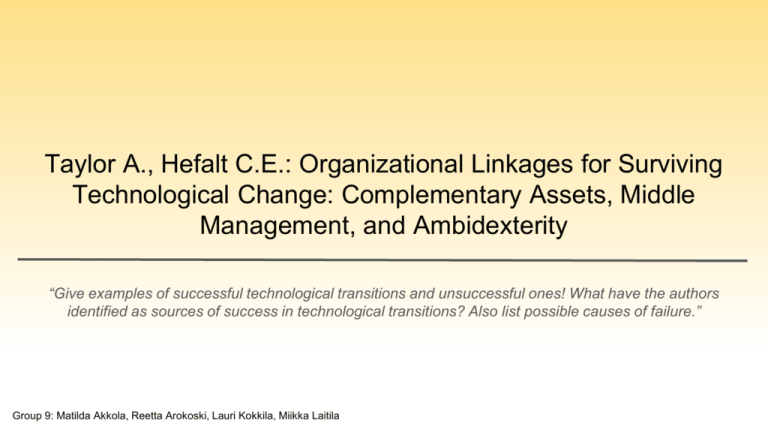
Taylor A., Hefalt C.E.: Organizational Linkages for Surviving Technological Change: Complementary Assets, Middle Management, and Ambidexterity “Give examples of successful technological transitions and unsuccessful ones! What have the authors identified as sources of success in technological transitions? Also list possible causes of failure.” Group 9: Matilda Akkola, Reetta Arokoski, Lauri Kokkila, Miikka Laitila “The Big Picture” Managerial influences Linking activities Influences that affect the willingness and ability of middle managers to perform linking activities Communication and coordination between and within units Technological transition Change from one technology to another Technological Transition in an Organization = change from one technology to another technology • New complementary assets may be required → The organization needs to keep up the old technology simultaneously while adopting the new technology, this is called ambidexterity Organizational linkages • Connect actors with different job responsibilities in an organization • To succeed with a technological transition, interaction between different parts of the organisation is required • Communication • Information flow • Sometimes it might be better to keep the old and new assets separate from each other • For example if the new technology is still under development 1 3 Types of Linkages 2 3 Picture // Taylor A., Hefalt C.E.: Organizational Linkages for Surviving Technological Change: Complementary Assets, Middle Management, and Ambidexterity The Importance of Middle Management • Work as linkages • Big role in the implementation of transition → Middle managers behavior is critical for the transition success • Motivation • • New technology might not be creating profit in the beginning, which might look like “worse” results than when working with the old technology Structures • top management can create necessary linkages, give instructions etc. The Framework Managerial influences Linking activities Organizational outcome Structural influences Organizational cognition Core Technology to complementary assets links Intercomplementary asset links Economic incentives Intracomplementary asset links Social context Technological transition Organisational Structure and Cognition STRUCTURAL INFLUENCES ORGANIZATIONAL COGNITION ”Structures that exist to link together or coordinate activities of interdependent subunits … including rules and procedures, planning and control systems, and specific coordinating units such as product team or task forces” (Nadler, 1978) ”Shared assumptions and understanding within a firm regarding how information is organized, how knowledge is coded and the relationships between different types of knowledge” (Walsh, 1995; DiMaggio, 1997) • • Organisational setting affect (organisational history) the shared assumptions. • Organisational cognition affects adoption of a new technology. • Cognition can be altered with relentless communication. • In turbulent environments, differentiated and less centralized organisational structures are adequate. Organizational structure should facilitate to utilize information across different units. Economic and social rewarding ECONOMIC INCENTIVES SOCIAL CONTEXT ”Monetary rewards and salary-increasing promotions to affect managerial behaviour.” ”Social rewards that prevail in organisational life include group affiliation, emotional support, selfesteem, social status, and salient identity.” • Rewarding managers that integrate the new technology and complementary assets • Under high uncertainty social status is a primary and prevalent influence on individual behaviour. • The challenge: most profits tend to come from the old technology during the transition + cannibalizing the old technology • Top management can provide clarity to the choice of the technology with social rewarding. • May not be sufficient! CASE EXAMPLE IBM (Successful) Before Computing Era (19391940) Transition (1940-1965) After the transition (1960) NCR (Unsuccessful) ● Revenue: $39,5M ● Mechanical tabulation, sales force management and service ● 90% market share in punchcard machines ● Revenue: $37,1M ● Mechanical tabulation, sales force management and service ● 88% market share in cash registers “Most successful transition into the new technology” (Taylor & Helfat, 2009) “One of the greater errors in the history of high technology” (Flamm 1988) ● Revenue: $3 239M ● Revenue: $665M Case IBM: Success factors of the transition 1. ECONOMIC • Leasing policy encouraged sales managers to focus on new technology 2. STRUCTURAL 3. SOCIAL • Fast promotions and informal status based on the knowledge of new technology 4. COGNITIVE • Cross-functional teams • • Dedicated units with coordination responsibility Clear message and vision of top management • Shared understanding of business focus • Responsible groups to make cognitive change Case NCR: Possible reasons for failure 1. ECONOMIC • Electronic (new) and mechanical (old) sales were competing • Electronics units had limited amount of salary promotions 2. STRUCTURAL • • 3. SOCIAL • Low formal and informal status for individuals with electronics knowledge 4. COGNITIVE Separate functions for new and old technology • Mixed messages • Mechanical cognitive frame maintained No rotation • Internal competition as a norm SUMMARY Managerial influences 1. 2. 3. 4. Economic Structural Social Cognitive CASE EXAMPLE A. IBM a. Focus on new tech b. Cross-functional teams c. Clear message and vision B. NCR a. Competing sales b. No rotation c. Mixed messages Linking activities 3 types of asset links: 1. Core to complementary 2. Intercomplementary 3. Intracomplementary Technological transition Change from one technology to another


